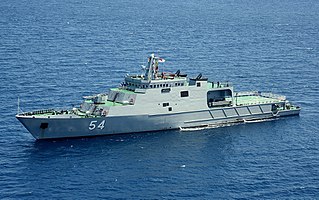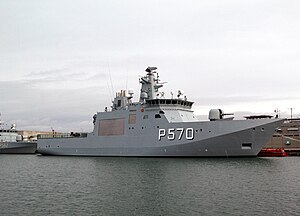
The Royal Danish Navy is the sea-based branch of the Danish Defence force. The RDN is mainly responsible for maritime defence and maintaining the sovereignty of Danish territorial waters. Other tasks include surveillance, search and rescue, icebreaking, oil spill recovery and prevention as well as contributions to international tasks and forces.
A patrol boat is a relatively small naval vessel generally designed for coastal defence, border protection, immigration law-enforcement, search and rescue duties. There have been many designs for patrol boats. They may be operated by a nation's navy, coast guard, police force or customs and may be intended for marine or estuarine or river environments. They are commonly found engaged in various border protection roles, including anti-smuggling, anti-piracy, fisheries patrols, and immigration law enforcement. They are also often called upon to participate in rescue operations.

The River class is a class of offshore patrol vessels built primarily for the Royal Navy of the United Kingdom. A total of nine were built for the Royal Navy (RN), four Batch 1 and five Batch 2. One Batch 1 (HMS Clyde), which was the Falklands guard ship, was decommissioned and transferred at the end of its lease to the Royal Bahrain Naval Force.

The Armidale class is a class of patrol boats built for the Royal Australian Navy (RAN). Planning for a class of vessels to replace the fifteen Fremantle-class patrol boats began in 1993 as a joint project with the Royal Malaysian Navy, but was cancelled when Malaysia pulled out of the process. The project was reopened in 1999 under the designation SEA 1444, with the RAN as the sole participant. Of the seven proposals tendered, the Austal/Defence Maritime Services (DMS) proposal for twelve vessels based on an enlarged Bay-class patrol boat was selected. Two additional boats were ordered in 2005 to provide a dedicated patrol force for the North West Shelf Venture.

The OTO Melara 76 mm gun is a naval gun built and designed by the Italian defence company Oto Melara. It is based on the Oto Melara 76/62C and evolved toward 76/62 SR and 76/62 Strales.

The Protector-class offshore patrol vessel is a ship class of two offshore patrol vessel (OPVs) operated by the Royal New Zealand Navy (RNZN) since 2010. The ships are named HMNZS Otago and HMNZS Wellington.

The Kedah-class offshore patrol vessels of the Royal Malaysian Navy (RMN) are six ships based on the MEKO 100 design by Blohm + Voss. Originally, a total of 27 ships were planned, but due to programme delays and overruns, only six were eventually ordered. Their construction began in the early 2000s, and by 2009, all six were in active service. The six vessels are named after Malaysian states.

Project Protector was a Royal New Zealand Navy (RNZN) procurement project that was undertaken during the 2000s. At the start of the decade, the New Zealand government tasked the New Zealand Defence Force to develop an equal combat, peacekeeping, and disaster relief capability, in which the RNZN was to focus on conducting sealift operations and patrols of the Economic Exclusion Zone. A series of reviews found that the RNZN was lacking in these capabilities, and Project Protector was established to acquire three new ship types: a single multi-role sealift ship, two offshore patrol vessels, and four inshore patrol vessels. After a two-year information-gathering and tender process, an Australian company, Tenix Defence, was selected as the primary contractor.

The Holland-class ocean-going patrol vessels are a class of four ocean-going patrol vessels constructed for the Royal Netherlands Navy. They are designed to fulfill patrol and intervention tasks against lightly armed opponents, such as pirates and smugglers, but have much higher level electronic and radar surveillance capabilities which are used for military stabilization and security roles, short of outright war. Without sonar or long range weapons, they utilize the surveillance capabilities of the Thales integrated mast, which integrates communication systems and two 4-faced phased arrays for air and surface search.

The Harry DeWolf-class offshore patrol vessels are warships of the Royal Canadian Navy (RCN) built by the Government of Canada Arctic and Offshore Patrol Ship (AOPS) procurement project, part of the National Shipbuilding Procurement Strategy. In July 2007 the federal government announced plans for acquiring six to eight icebreaking warships for the RCN.

HDMS Ejnar Mikkelsen is a Royal Danish Navy patrol vessel. Launched in November 2007, she is the second vessel of the Knud Rasmussen class. The normal patrol area of the Ejnar Mikkelsen, and her sister ships, will be the waters around Greenland.

StanFlex is a modular mission payload system used by the Royal Danish Navy. Originally conceived during the 1980s as a way of replacing several classes of minor war vessel with a single class of multi-role ships, the StanFlex system consists of weapons and equipment mounted in standardised containers, which can be loaded into slots on the ships. These containers can be swapped out in a short period of time, allowing the ship to switch between roles when needed. The success of the modular payload system led the Royal Danish Navy to design all new warships with StanFlex slots, and to install slots on older vessels during major refits. By 2012, nine ship classes capable of carrying StanFlex payloads were in service.

The Arafura class is a class of offshore patrol vessels being built for the Royal Australian Navy (RAN). Initially proposed in the 2009 Defence White Paper and marked as procurement project SEA 1180, it was originally planned that 20 Offshore Combatant Vessels (OCV) would replace 26 vessels across four separate ship classes: the Armidale-class patrol boats, the Huon-class minehunters, the Leeuwin-class survey vessels, and the Paluma-class survey motor launches. Although having a common design, the ships would use a modular mission payload system to fulfill specific roles; primarily border patrol, mine warfare, and hydrographic survey. The 2013 Defence White Paper committed to the OCV project as a long-term goal, but opted in the short term for an accelerated procurement of an existing design to replace the Armidales, and life-extension refits for the other types. This resulted in the Offshore Patrol Vessel (OPV) project and the amount of vessels reduced to 12. However, this was further increased to 14 when 2 further Mine Counter Measures variants were proposed under SEA 1905.

HDMS Knud Rasmussen is a Royal Danish Navy patrol vessel. Knud Rasmussen and her sister ships normally operate in the waters around Greenland.

HTMS Krabi (OPV-551) is an offshore patrol vessel (OPV) of the Royal Thai Navy. She is a modified River-class patrol vessel, and was built by Mahidol Adulyadej Naval Dockyard, with design and technology transfer support from BAE Systems Surface Ships. Additional construction took place at the Royal Thai Navy Mahidol Dockyard in Sattahip.

The Kership class is a range of steel monohull offshore patrol vessels (OPVs) built by Kership, a joint venture of French civil shipbuilder Piriou (55%) and Naval shipbuilder DCNS (45%).
Margaret Brooke is the second Harry DeWolf-class offshore patrol vessel for the Royal Canadian Navy. The class was derived from the Arctic Offshore Patrol Ship project as part of the National Shipbuilding Procurement Strategy and is primarily designed for the patrol and support of Canada's Arctic regions. Named after Sub-Lieutenant Margaret Brooke, a Royal Canadian Navy Nursing Sister and who tried to save another person during the sinking of the ferry SS Caribou during World War II. Margaret Brooke was ordered in 2011, laid down in 2016 and launched in 2019. The vessel began contractor sea trials in May 2021, and it was delivered to the Royal Canadian Navy for post-acceptance sea trials on 15 July 2021. The official naming ceremony for the ship was conducted on 29 May 2022 in conjunction with that for sister ship Max Bernays.

The Inlay-class offshore patrol vessel is a class of offshore patrol vessel (OPV) operated by the Myanmar Navy.The lead ship of the class is UMS Inlay. UMS Inlay was built at Thanlyin Naval Dockyard near Yangon with the help of technical assistance and equipment provided by Singapore-based companies. Launched by late November 2015, Inlay had been very largely completed by April 2017.

William Hall. will be the fourth Harry DeWolf-class offshore patrol vessel for the Royal Canadian Navy. The class was derived from the Arctic Offshore Patrol Ship project as part of the National Shipbuilding Procurement Strategy and is primarily designed for the patrol and support of Canada's Arctic regions. Named after Quartermaster William Nelson Edward Hall, who was the first African Canadian to receive the Victoria Cross. He received the medal for his actions in the 1857 Siege of Lucknow during the Indian Rebellion.

Max Bernays will be the third Harry DeWolf-class offshore patrol vessel for the Royal Canadian Navy. The class was derived from the Arctic Offshore Patrol Ship project as part of the National Shipbuilding Procurement Strategy and is primarily designed for the patrol and support of Canada's Arctic regions.
















